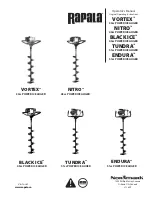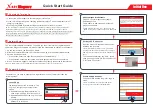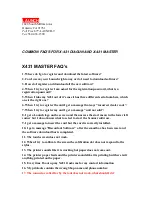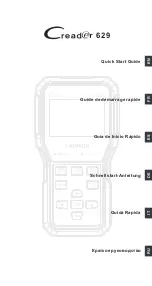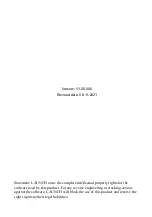
MIROxi
User Manual cod. 980265
Rev 1.6
Page 4 of 32
1. INTRODUCTION
1.1
Intended Use
The MIROxi pulse oximeter is intended to be used by a physician or by a patient under the instruction of a physician or
paramedic.
The device is intended to test lung function and can make oximetry testing in people of all ages.
It can be used in any setting.
1.1.1
User Category
The
MIROxi
oximeter calculates a series of parameters relating to human respiratory function.
Typically the doctor “prescribes” the use of the device and is responsible for analysing and controlling the results
obtained.
1.1.2
Ability and experience required
The correct use of the device, the interpretation of the results and the maintenance of the device all require qualified
personnel. In the event that the device is operated by the patient, then sufficient training must first be given to the patient
by the doctor or by the trained paramedic under the supervision of the doctor.
WARNING
The manufacturer cannot be held responsible for any damage caused by the user of the device failing to
follow the instructions and warnings contained in this manual.
MIROxi is intended for spot-checking, overnight sleep screening and/or continuous monitoring when
attended by a trained healthcare professional.
1.1.3
Operating environment
MIROxi
has been designed for use in a doctor’s office, in a hospital or directly by the patient during day-to-day activities
for the monitoring of physical conditions. All information necessary for the proper use of the device in electromagnetic
environments (as required by the EN 60601-1-2 Standard) is available from the manufacturer.
Used at home, at work, at school or during sports, day by day the device records data and functional respiratory
parameters for a period of weeks or months, assisting the patient in making a better assessment of hisor her own health.
The procedures for using the device at home are described according to the type of test to be made; the display will
show all instructions (messages, suggestions etc.) step-by-step, which allows the subject to correctly perform tests and
obtain correct results, to be analysed by the doctor.
The instrument is not intended for use in an operating theatre nor in the presence of inflammable liquids or detergents,
nor in the presence of inflammable anaesthetic gases (oxygen or nitrogen).
The instrument is not designed to be used in direct sources of heat or cold, direct sun rays or other sources of light or
energy, dust, sand or any other chemical substances.
The user and/or the doctor are responsible for ensuring that the device is stored and used in appropriate environmental
conditions;
in this regard reference is made to the specifics described in paragraph 1.6.1 below.
WARNING
If the device is exposed to unsuitable environmental conditions, this could cause the device to malfunction
and to give incorrect results.
1.1.4
Who can or must make the installation
The device requires installation by qualified personnel. Normally the doctor configures the instrument before giving it to
the patient for use at home.
1.1.5
Subject effect on the use of the device
Patient collaboration is not required to make oximetry testing.
1.1.6
Limitations of use - Contraindications
An analysis of the results of oximetry testing is not by itself sufficient to make a correct diagnosis of the subject’s clinical
condition. A detailed clinical history of the subject is required together with the results of any other test(s) suggested by a
doctor.
Test comments, a test interpretation and suggested courses of treatment must be given by a doctor.
Any symptoms that the subject has at the time of the test must be carefully considered before a oximetry test is made.
The user is responsible to assess both the mental and the physical capacity of the subject in order to make a correct test.
The acceptability of a test is the responsibility of the user.




























